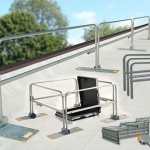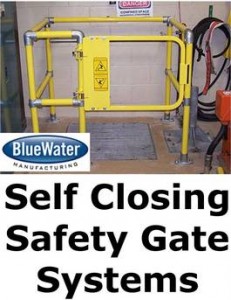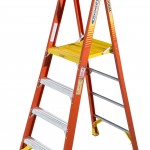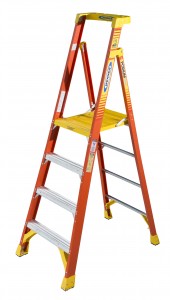Effective August 1, 2016; OSHA will increase the max fine amount from $70,000 to $124,000 for willful (knowing the law but ignoring it) and repeat violations. You know the law – do not fail to train your crew.
Category Archives: OSHA fall prevention
Roof Guard Rail System
 When employees are required to do maintenance on the heating and cooling equipment located on the roof they must be protected from falls. The solution must comply with OSHA (Standards-29CFR) 1910.23 and 1926.502. The simplest way to do this is with a roof guard rail system that is easy to install, requiring no tools and does not damage the roof. Roof Zone has developed a product, the RZ Guardrail System, that meets these requirements. Made in the USA, it’s the quickest and easiest guardrail system to install and remove, requiring no tools, no permanent installation, and galvanized to eliminate rust issues.
When employees are required to do maintenance on the heating and cooling equipment located on the roof they must be protected from falls. The solution must comply with OSHA (Standards-29CFR) 1910.23 and 1926.502. The simplest way to do this is with a roof guard rail system that is easy to install, requiring no tools and does not damage the roof. Roof Zone has developed a product, the RZ Guardrail System, that meets these requirements. Made in the USA, it’s the quickest and easiest guardrail system to install and remove, requiring no tools, no permanent installation, and galvanized to eliminate rust issues.
The guardrail base mount is hot-dipped galvanized with protective protective vinyl pads attached to protect roof. The base holds two rails and comes with easy grip openings on each for one or two persons to carry. Optional toe board brackets are available. The galvanized guard rail are available in 6 ft., 8 ft. and 10 ft. length. For roof hatch or skylight applications, a swing gate guardrail is available.
For applications where it is required to maintain sight lines while offering fall protection an optional collapsible guardrail bracket is available so the guard rail system can be laid down on the roof to maintain architectural integrity.
Please visit our website for more info or call us at 800-776-3595 for more information.
Self Closing Safety Gate

The best way to stop a fall is to eliminate the hazard. By using a self closing safety gate many falls can be prevented. Applications for a safety gate would be: ladderway openings, stairwell openings, equipment access ladders, scaffolding, mezzanines, and working platforms to name a few. Safety gates can be ordered painted safety yellow, hot-dipped galvanized, stainless steel, or aluminum. They are shipped fully assembled, meet OSHA standards, self closing, and are easy to install. They feature dual stainless steel springs, adjustable lengths, and reversible swing direction by simply inverting gate. Such a simple solution to eliminate a fall.
OSHA Job Site Safety
This summer OSHA is promoting two new job site safety programs. The first is OSHA’s National Stand Down. The week of June 2nd thru 6th will be their week to raise awareness of preventing fall hazards in construction. In 2012, 269 construction worker fatalities out of a total 775 were caused by falls. Many of those deaths were preventable by proper job planning and instruction. Fall prevention safety standards were among the top 10 most frequently cited OSHA standards, during fiscal year 2012. Here is a link to planning a step down program for your organization.
In conjunction with this program they are concurrently promoting OSHA’s Plan, Provide, Train program. Using OSHA’s three simple step program, many job related falls can be prevented. OSHA’s website is part of a nationwide outreach campaign to raise awareness among workers and employers about the hazards of falls from ladders, scaffolds and roofs. Plan ahead to get the job done safely. Provide the right equipment equipment. Train everyone to use the safety equipment safely. Three simple steps that save lives.
Bird Ladder Open House May 15th
Bird Ladder will be having their annual open house May 15th. Every year we have customer appreciation day which includes a truck load sale on everything. Werner ladders, pump jacks, planks, Granite scaffolding, MBW compactors, trowels and mixers, Werner fall protection, Acro roofing equipment, Tie down shingle hoists, Van Mark brakes, Knaack job boxes, Weatherguard truck and van equipment, Reechcraft PowerPole, PowerLift and PowerMast to name a few.
We will also have factory reps demonstrating their products. We will be introducing new products at the show. The NEW Knaack 118 data vault will be on display with demonstrations. We will also have the new Reechcraft Powermast set up. They also have a new free standing base that will be shown. We will also have new MBW plate compactors on display.
Free safety classes will also be returning this year. We will offer ladder safety courses, fall protection courses and also a presentation by Acro products on use of their roof edge protection. Cards will be issued for the ladder and fall protection training. We are also attempting to have a representative from OSHA here to answer questions.
We also serve lunch from 12:00 till the food runs out. So bring your shopping list, save money, get trained, and have lunch.
Podium Ladder promoted by Coach Tom Izzo
Podium ladder from Werner.
Coach Tom Izzo who has cut down many nets at NCAA finals is helping Werner promote their new fiberglass Podium ladder. Ideal for working at fixed heights and easier to maneuver than scaffolds or lifts. Another advantage this fiberglass podium ladder offers in non conductivity. Fiberglass does not conduct electricity, so it is much safer to use around electrical sources than highly-conductive aluminum. The extra-large podium platform with toe guard feels like you are standing on the ground and 4X Work Zone allows you to work facing any direction. This podium ladder features full aluminum bracing and a full set of rear horizontals. The extended guardrail provides an extra point of contact and conveniently organizes tools and accessories. The newly designed EDGE360™ gives the bottom of the ladder protection from every angle with integrated rail shield, EDGE bracing and over-sized foot pads.
Using a platform type ladder reduces fatigue, increases productivity, and is safer than a standard step ladder.
WernerCo. Podium Ladder – A New Design for Platform Ladders
WernerCo. has introduced a new platform ladder called the Podium which is ideal for working at fixed heights and is designed to provide a full range of motion while providing protection at every angle.
The Podium ladder uses the LOCKTOP™ design which organizes tools at the top of the ladder which also functions as an integrated waist-high guard rail that securely wraps around the work zone. The ladder also features the EDGE360™ bracing system that gives protection from every angle on the over-sized platform which allows four times the work zone then a standard ladder.
Mark Peters, Director of Marketing at WernerCo. stated that “We designed our new Podium Ladder to help prevent misuse and falls. While safety is the most important feature, we also know that comfort, mobility and access are important to our customers who have to stand on a ladder for extended periods of time. The new Podium Ladder includes an actual standing platform vs. a traditional ladder step that allows for increased reach and range of motion. The best part, it feels like the user is standing on the ground instead of on a ladder.”
Safety Pays, but Falls Cost
Here is a copy of an article I found written by Jim Maddux, director of OSHA Directorate of Construction. Take a few minutes to read it.
Safety Pays, but Falls Cost
OSHA’s Fall Prevention Campaign promotes ‘Planning,’ ‘Providing’ and ‘training’ to reduce the number one cause of death in construction
By Jim Maddux, director, OSHA Directorate of Construction
Falls account for one third of all work-related deaths in the construction industry. In 2010, there were 264 fall fatalities (255 falls to lower level) out of 774 total fatalities in construction. Of those deaths from falls, 90 were from roofs, 68 from ladders and 37 from scaffolds.
Many of the workers who are killed and injured on the job are temporary workers who perform the most dangerous jobs and often have limited English proficiency, and who don’t always get the training and equipment they need to do their jobs safely. As Assistant Secretary of Labor for Occupational Safety and Health Dr. David Michaels has said, “All workers have the right to go home safe and sound at the end of the day, whether they’ve been on the job one day or 25 years.” Continue reading
OSHA Scaffold Citation
Here is an article I found that may be on interest to you. Be sure when your employees are working on scaffold that they have had training on the proper use of scaffold. ! fine like this could be devastating to the profit from the job.

| Region 2 News Release: 13-1858-NEW/BOS-13-162 Sept. 24, 2013 Contact: Ted Fitzgerald Andre J. Bowser Phone: 617-565-2075 617-565-2074 Email: fitzgerald.edmund@dol.gov bowser.andre.j@dol.gov US Labor Department’s OSHA proposes more than $272,000 in fines, cites NEW YORK – The U.S. Department of Labor’s Occupational Safety and Health Administration has proposed $272,720 in fines against four New York contractors for safety hazards identified during the construction of a midtown Manhattan hotel. The March 21 inspection was conducted in response to a complaint about fall hazards at the 325 W. 33rd St. work site. The largest penalties of $249,920 are proposed for Flintlock Construction Services LLC, the Mamaroneck-based general contractor for the construction of the 23-story hotel. Flintlock was cited for seven violations of OSHA’s fall protection and scaffolding standards that involved workers exposed to potentially fatal falls of up to 26 feet while they were on scaffolding. “These employees were one trip, slip or misstep away from a deadly or disabling fall. Falls are the leading cause of death among workers in construction,” said Kay Gee, OSHA’s area director for Manhattan, Brooklyn and Queens. “There is no excuse for an employer’s failure to supply and ensure the use of legally required safeguards that can prevent injuries and save lives. The sizable fines proposed reflect both the severity of these hazards and that Flintlock was aware of, and failed to correct, the hazards.” Specifically, Flintlock failed to provide and ensure the use of fall protection, such as guardrails or personal fall- arrest systems, for workers on the scaffold; the scaffold lacked a safe means of access, causing workers to climb its cross-bracing to reach their work platforms; the work platforms were not fully planked; and the scaffold was not tied off to restrain it from tipping. These conditions resulted in the issuance of four willful citations, with $233,200 in fines to Flintlock. OSHA also issued three serious citations, with $16,720 in fines, to Flintlock for additional hazards. These include failing to provide training on the hazards associated with erecting scaffolds; failing to have a competent person determine the feasibility of providing fall protection for workers erecting and dismantling the scaffolding; a scaffold walkway that was too narrow; and inadequate anchorage for the fall protection system. V&P Altitude Corp., a Brooklyn-based siding contractor, was issued five serious citations, with $13,200 in fines, for lack of fall protection; no safe access to the scaffolding; not fully planking the scaffold platforms; failing to tie off the scaffolding; and not locking mobile scaffold wheels and casters. SMK Associates, an Astoria-based masonry contractor, was issued three serious citations, with $7,600 in fines, for electrical hazards and failing to provide eye and face protection. Maspeth Steel Fabricators Inc., a Maspeth-based steel framing contractor, was issued one serious citation, with a $2,000 fine, for failing to provide training on the hazards of working on scaffolds. The citations can be viewed at http://www.osha.gov/ooc/citations/FlintlockCitations.pdf*,http://www.osha.gov/ooc/citations/SMKCitations.pdf*, http://www.osha.gov/ooc/citations/VPCitations.pdf* andhttp://www.osha.gov/ooc/citations/MaspethCitations.pdf*. A willful violation is one committed with intentional, knowing, or voluntary disregard for the law’s requirements, or with plain indifference to worker safety and health. A serious violation occurs when there is substantial probability that death or serious physical harm could result from a hazard about which the employer knew or should have known. Due to the nature and severity of violations committed by Flintlock Construction Services LLC, the general contractor has been placed in OSHA’s Severe Violator Enforcement Program, which mandates targeted follow-up inspections to ensure compliance with the law. OSHA’s SVEP focuses on recalcitrant employers that endanger workers by committing willful, repeat or failure-to-abate violations. Under the program, OSHA may inspect any of the employer’s facilities if it has reasonable grounds to believe there are similar violations. Each employer has 15 business days from receipt of its citations and proposed penalties to comply, meet with OSHA’s area director, or contest the findings before the independent Occupational Safety and Health Review Commission. OSHA has created a Stop Falls Web page at http://www.osha.gov/stopfalls, which has detailed information in English and Spanish on fall protection hazards and safeguards. The page offers fact sheets, posters and videos that vividly illustrate various fall hazards and appropriate preventive measures. To ask questions, obtain compliance assistance, file a complaint or report workplace hospitalizations, fatalities or situations posing imminent danger to workers, the public should call OSHA’s toll-free hotline at 800-321-OSHA (6742) or the agency’s Manhattan Area Office at 212-620-3200. Under the Occupational Safety and Health Act of 1970, employers are responsible for providing safe and healthful workplaces for their employees. OSHA’s role is to ensure these conditions for America’s working men and women by setting and enforcing standards, and providing training, education and assistance. For more information, visit http://www.osha.gov. |
Construction Rises to the Top Spot in Labor Statistics’ Deadliest Industries List
 Fatal work injuries in the private construction sector increased 5 percent to 775 in 2012, while total hours worked in the industry increased just one percent.
Fatal work injuries in the private construction sector increased 5 percent to 775 in 2012, while total hours worked in the industry increased just one percent.
The 2012 increase in fatal occupational injuries follows five consecutive years of declining fatalities in construction. Fatal construction injuries are down 37 percent since 2006.
The reversal in construction’s worker-fatality trend is stark in light of the fact that the 2012 fatal-work-injury count for all U.S. employers is down 6.6 percent to the second-lowest total since the U.S. Bureau of Labor Statistics first started conducting the Census of Fatal Occupational Injuries in 1992
The rate of fatal work injury for all U.S. workers in 2012 was 3.2 per 100,000 full-time equivalent workers, down from a rate of 3.5 per 100,000 in 2011. There were 9.5 U.S. construction-worker deaths in 2012 per 100,000 full-time workers.





